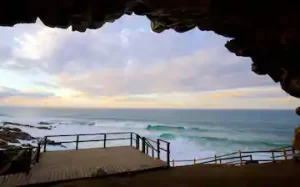The Cape St Blaize Cave – Mossel Bay:
Nestled in Mossel Bay, the Cape St Blaize Cave offers a journey back in time. The Garden Route of South Africa is dotted with numerous prehistoric sites, where stone tools and rock art have been unearthed. Among the earliest excavated sites is the Cape St Blaize Cave, situated beneath the town’s lighthouse from the 19th century.

Mossel Bay and Cape St Blaize Cave:
Mossel Bay holds the distinction of being the first landing spot for Europeans in southern Africa in the 15th century. However, its history extends far beyond that, as it is believed that the region’s inhabitants from 200,000 years ago are ancestors to everyone alive today.
Located to the east of Mossel Bay, the Cape St Blaize Cave is a natural grotto with a commanding view of the sea, making it a prime location for early humans. The cave, with its vast dimensions of 10 meters in height and 72 meters in width, provided ample shelter. The proximity to the sea ensured a rich diet of shellfish for its early inhabitants, as evidenced by archaeological findings.
The cave continued to be inhabited until the arrival of Europeans in the 15th century. Although humans eventually vacated the cave, it became a refuge for bats and earned the nickname “Bat’s Cave.” Nowadays, it is home to curious dassies, small furry animals related to elephants.

A Significant Archaeological Site:
The initial excavations at Cape St Blaize in 1888 uncovered artifacts dating back 80,000 years, indicating Middle Stone Age occupation. However, newer evidence points to habitation by the San (or Khoekhoe) people approximately 800,000 years ago. This suggests that the Mossel Bay area could have been the cradle for the very first humans from whom we all descend.
While exploring Cape St Blaize, be sure to visit the lighthouse situated directly above the cave, adding another layer to the area’s rich historical tapestry.
![]()




